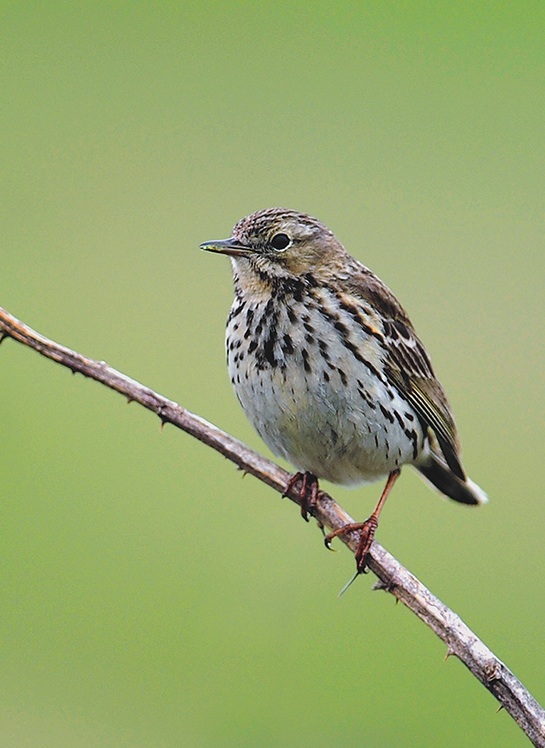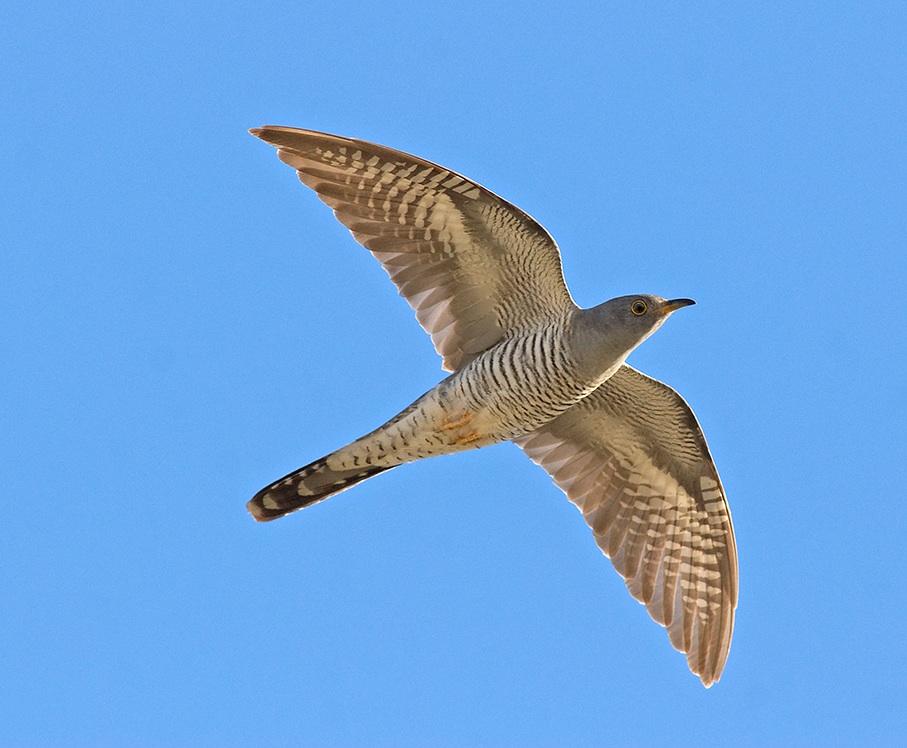We continued from Ian’s reception on to the pub, and over a beer the conversation moved on to what should be another safe subject in Dorset: what date did you hear your first cuckoo this year? Down the road in Wareham, tradition has it that cuckoos hibernate in hollow trees. Each year the first cuckoo in Dorset to wake up and call is in Purbeck, where on 17 April he goes to Wareham’s spring fair and “buys hisself a pair of breeches” (Legg 2000). Ian Lewis explained that when the weather is bad, birds arriving earlier die, while those with the habit of coming later survive, and so birds adapt to the changing climate. Cuckoos are 10 days earlier now in Purbeck, arriving sometime between 3 and 9 April, so the risk of arriving earlier is not as high as it used to be.
I knew cuckoos didn’t hibernate in trees, but until recently I did believe that females were able to vary the pattern of their eggs to match those of the potential host, say one year Reed Warbler and another year Meadow Pipit. I’m not sure what I thought was going on (tiny fairies with paint brushes?), but it’s not true. Common Cuckoos lay eggs with genetically predisposed patterns that fit their specific host. This means that female cuckoos can be divided into ‘host specific races’, and pass their preference on to their female young, who lay their eggs in nests of the same species that brought them up. Research into Hungarian cuckoo calls by Fuisz & de Kort (2007) suggests that male cuckoos in marshes call differently from males in forests.

Meadow Pipit Anthus pratensis, Hartland Moor, Dorset, 3 May 2010 (Nick Hopper)
If this proves correct, it could mean that males also belong to ‘host specific races’, some for example pairing with females that lay in Reed Warbler nests, and others with females that lay in Meadow Pipit nests. So perhaps when we hear ‘the’ cuckoo we are not listening well enough.
Listen to a recording of a classic ‘reedbed cuckoo’, singing along with a group of Reed Warblers (CD2-89). For a little light entertainment, compare it to this ‘forest cuckoo’ recorded in Poland (CD2-90). The main difference you will hear between these two examples (the higher pitch of the reedbed cuckoo, especially in the second note) is exactly what Fuisz and de Kort found.
CD2-89: ‘Reedbed Cuckoo’ Cuculus canorus and Eurasian Reed Warbler Acrocephalus scirpaceus Middlebere, Poole Harbour, Dorset, UK, 04:32, 8 May 2010. Song of a male, to the accompaniment of reed warblers, the probable guardians of its offspring. Background: Common Pheasant Phasianus colchicus, Common Wood Pigeon Columba palumbus, European Robin Erithacus rubecula, Common Blackbird Turdus merula, Common Whitethroat Sylvia communis, European Blue Tit Cyanistes caeruleus and Long-tailed Tit Aegithalos caudatus. 100508.MC.043200.02
CD2-90: ‘Forest Cuckoo’ Cuculus canorus Białowieża forest, Podłaskie, Poland, 20:30, 3 May 2005. Much lower-pitched song of a cuckoo in a forest habitat. Background: European Tree Frog Hyla arborea, Eurasian Woodcock Scolopax rusticola and Song Thrush Turdus philomelos. 05.006.MR.04331.01
At Ian’s wedding, it soon became apparent that none of us was noticing as many cuckoos as we used to. British cuckoo numbers dropped by 58% between 1970 and 2008 (Eaton et al 2010), and I suggested to the others that it wasn’t so bad in Poole. Terry thought that as Meadow Pipits had gone from his patch, so had the cuckoos. Shaun remarked that he only heard migrant cuckoos a couple of times a spring at Lytchett. We talked through the usual confusing array of reasons for the decline, including global warming, with flowers and the insects that depend on them appearing earlier and the host species breeding earlier. Someone added that increasing desertification in Africa was causing problems on the wintering grounds. Intensive farming in Britain was also blamed.
Cuckoos mainly eat caterpillars, especially the hairy ones avoided by other birds. They like tiger moths Arctiidae, which declined by 45% in Britain from 1966 to 2005. These in turn depend on common weeds like dandelion Taraxacum, nettles Urtica, dock Rumex, and brambles Rubus. We suspect that there may be an echo of Grey Partridge here: twice the productivity for supermarkets, half the weeds, half the hairy caterpillars, half the food for cuckoos, half the cuckoos?

Common Cuckoo Cuculus canorus, Zhabagly, Kazachstan, 18 September 2009 (René Pop)
Living in the town, we don’t notice the decline. With farmers hiring in contractors who harvest the crops, sitting oblivious inside giant soundproof tractor cabs, it becomes easier to understand how the silence in the farmland has crept up on us. If we want to be part of a future where we still hear cuckoos, we must change our demands on supermarkets, forcing farmers to adopt more wildlife-friendly practices, and we need to do it today.
When I first went birding around the harbour, telling Willow Tit from Marsh Tit was an issue. Not anymore, because Willow Tit has disappeared. In A climatic atlas of European breeding birds, Huntley et al (2007) predicted it would move north with the warming climate. We don’t know how much further north, but in 1997 someone did estimate that natural habitats and agriculture would move northwards by 50-80 km a decade. Within 90 years, Huntley et al anticipated fewer Gannets breeding in the English Channel, the loss of Fulmar and Black-legged Kittiwake here, and a northward shift in the range of Shelduck so that Poole Harbour may become the last breeding site in southern England.
Sea levels rise as water warms, and while one centimetre rise in 30 years may seem modest, the massive gull colonies of Holton Heath only need to flood once each spring to force the gulls to move elsewhere. Such apparently modest flooding can also devastate the thriving diversity of invertibrates breeding in the ditches, and the ducks and waders that feed on them. Meanwhile, dwindling or northward shifting fish stocks could affect the tern colonies.
It makes little difference to the average bird in the tree, or come to think of it, the average birder in the street what has caused the warmer weather. It only matters that it exists. Remove the tree or kill all the insects on it, however, and you have a real problem. As the temperature increases so the flora changes, tides reshape the land, winds change speed and direction and birds have to make do. Nick (a very typical birder) likes to joke, “It won’t be long before we get our next Mediterranean period, but this time we’ve got to pay tax on it,” before parodying the parochial English response to warmer weather, “Bring it on!” If you are able to blinker yourself to the tropical end of the problem and read of the birds Huntley et al believe will be here in Poole, it’s tempting to agree with him.
“Bring it on,” is also how the birders at Ian and Margaret’s wedding responded when Nick and I told them about the breeding forecasts in Huntley et al’s Atlas. Breeding Little Bitterns, Night Herons and Purple Herons, yes please! Honey Buzzards should become commoner, and we can look forward to seeing more and more Black Kites. We might get vagrant Egyptian Vultures and Bonelli’s Eagles on a regular basis. Goshawks could resume regular breeding, preying on Turtle Doves escaping the heat in France. Quails could breed again, as could Spotted Crakes, Corn Crakes and Little Bustards, and we could have the occasional breeding pair of Black-winged Stilts or Kentish Plovers.
We could look forward to Crested Larks singing in the dunes and Black Redstarts breeding around my offices. Migrant Rock Thrushes exploring the old stone workings around Corfe Castle, being expelled from the turrets by territorial Blue Rock Thrushes. Cisticolas ‘zitting’ on the edge of the saltmarsh, and Savi’s Warblers reeling at Lytchett. Crested Tits, Short-toed Treecreepers, Long-eared Owls and Scops Owls calling in the conifers. Migrant Moustached Warblers overshooting from northern France, meeting Melodious Warblers that used to breed no further north than there. Sardinian Warblers starting to take over any niche left vacant by our Dartford Warblers and Common Whitethroats. Elsewhere, the occasional Western Orphean Warbler singing from an orchard in Wareham, to the accompaniment of Golden Orioles breeding in trees along the Piddle…
[We had forgotten to mention termites, and at this point I revealed that malarial mosquitoes would be able to breed permanently again in Poole, although a recent study had concluded that the drainage of much of the marshes made this unlikely.]
…Rock Sparrow, Serin and Hawfinch becoming year-ticks, migrating past South Haven, and Nick’s flight call detectors at Stoborough regularly picking up Cirl Bunting, Rock Bunting and Ortolan Bunting passing at night. Alpine Swift nesting on the Barclays building, and Pallid Swift on the cliffs near Old Harry. Bee-eaters breeding on the Piddle at Trigon and Wrynecks calling from the bushes at Rempstone. Great Grey Shrike and Woodchat Shrike peering down at us from roadside wires and last but not least, Hoopoe everywhere… OK, they didn’t actually suggest that all these birds would be where we put them, but it’s good to dream. After all, the ways of nature are always full of surprises…
At this point Ian Alexander, overhearing us drifting slowly off into cloud cuckoo land, popped in a little caveat. “Adding large volumes of fresh water to the Arctic reduces the salinity, which stops the water in northern latitudes sinking, and it is this sinking water that powers the Gulf Stream. If the Gulf Stream slows (or, less likely, stops) then we may see a different chain of events – and that could be the beginning of a series of cold winters.”
>>> Chapter 26: A new England? >>>